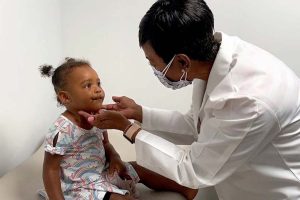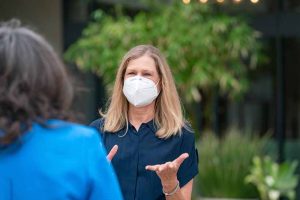Beyond the virus: Health impacts of the pandemic
 When the COVID-19 pandemic began, researchers and physicians at Kaiser Permanente Southern California quickly recognized that its effects would reverberate far beyond the novel respiratory illness itself. This public health crisis would have an unprecedented impact on a range of additional health conditions and health care delivery concerns. With that foresight, as the pandemic progressed, researchers began to monitor its broader impacts.
When the COVID-19 pandemic began, researchers and physicians at Kaiser Permanente Southern California quickly recognized that its effects would reverberate far beyond the novel respiratory illness itself. This public health crisis would have an unprecedented impact on a range of additional health conditions and health care delivery concerns. With that foresight, as the pandemic progressed, researchers began to monitor its broader impacts.
One of the earliest secondary effects was a dramatic drop in the number of childhood vaccine doses — including the measles vaccine — administered during the first 6 months of the pandemic, according to Kaiser Permanente research reported in Pediatrics. The study found that this decline was less severe and rebounded more quickly for children under 2 than for older children.
“At the start of the pandemic, it was immediately clear that fewer parents were bringing their children in for office visits, most likely due to pandemic safety concerns,” said the study’s lead author, Bradley Ackerson, MD, a Kaiser Permanente South Bay Medical Center pediatric infectious disease specialist and an investigator with the Department of Research & Evaluation.
 To understand the pandemic’s effects, researchers evaluated vaccinations for nearly 1 million children 18 and younger at Kaiser Permanente Southern California, comparing rates for January through August 2020 with the same timeframe in 2019. They assessed both vaccine uptake, which is the number of children receiving vaccines, and vaccine coverage, the proportion of children of a given age who have been vaccinated with specific vaccines.
To understand the pandemic’s effects, researchers evaluated vaccinations for nearly 1 million children 18 and younger at Kaiser Permanente Southern California, comparing rates for January through August 2020 with the same timeframe in 2019. They assessed both vaccine uptake, which is the number of children receiving vaccines, and vaccine coverage, the proportion of children of a given age who have been vaccinated with specific vaccines.
The analysis showed that uptake of all recommended vaccines declined in early 2020. However, while uptake rebounded completely for children under 2 by May 2020, it only partially rebounded for older kids. In particular, despite some rebound, measles vaccinations remained lower in 2020 than in 2019, causing measles vaccination coverage to decline.
“Decreases in vaccination coverage raised concerns about increased risk of transmission and outbreaks, especially as schools reopened and international travel resumed,” Dr. Ackerson said. “We were particularly worried about measles because even small declines in vaccination coverage could lead to exponential increases in outbreaks.”
Clinicians at Kaiser Permanente Southern California implemented strategies to ensure ease of access to childhood vaccinations and to alleviate parents’
concerns about the safety of medical visits during the pandemic. These included opening drive-through vaccination sites, applying distancing and hygiene measures, and reaching out directly to parents of unvaccinated children.
“In addition, we developed algorithms that alerted providers when children are due for certain vaccines so that at each visit, we never miss an opportunity to keep up with recommended vaccinations,” Dr. Ackerson said.
Anxiety, depression, and exercise
As the pandemic set in, people around the world faced a number of stressors, including reduced or altered business practices, financial problems, and fewer opportunities to socialize with friends and family. These factors led to increased symptoms of depression and anxiety.
 A Kaiser Permanente study revealed that people who exercised and spent time outdoors experienced lower levels of anxiety and depression. The research, published in Preventive Medicine, was led by Deborah Rohm Young, PhD, MBA, the director of the Division of Behavioral Research for the Department of Research & Evaluation.
A Kaiser Permanente study revealed that people who exercised and spent time outdoors experienced lower levels of anxiety and depression. The research, published in Preventive Medicine, was led by Deborah Rohm Young, PhD, MBA, the director of the Division of Behavioral Research for the Department of Research & Evaluation.
“We already knew that physical activity and time spent outdoors are linked to better mental health in nonpandemic times,” Dr. Young said. “We saw that these associations held up during the initial pandemic lockdown period.”
The study began in April 2020, when researchers launched a series of COVID-19–related surveys to over 200,000 Kaiser Permanente members who volunteered to participate in the Kaiser Permanente Research Bank — an initiative that combines lifestyle surveys with biospecimens. Those with COVID-19 symptoms were excluded from this analysis, leaving a final pool of more than 20,000 participants from 6 regions served by Kaiser Permanente across the United States. They completed at least 4 surveys from April through July 2020.
Overall, anxiety and depression scores decreased over time for the participants, most of whom were older, retired, white women who reported that they had followed “safer-at-home” orders to limit COVID-19 spread. Female and younger participants had higher levels of anxiety and depression, while Asian and Black participants had lower anxiety and depression than white respondents.
People who exercised the most had the lowest anxiety and depression scores. While participants who spent less time outdoors had higher levels of anxiety and depression, those with the greatest increase in time spent outdoors had higher anxiety.
“The take-home message is that maintaining physical activity during these difficult times has a number of benefits,” Dr. Young said. “Regular exercise, even going for a nice, brisk walk every day, is the ’pill’ that people need.”
The findings also suggest the importance of maintaining safe access to outdoor areas, including parks and trails.
Children gained excess weight
Other researchers were particularly interested in potential secondary effects of pandemic conditions on weight gain in children. A study of Kaiser Permanente Southern California members ages 5 to 17 found that they gained more weight during the pandemic than would normally be expected. Published in JAMA, the analysis showed that children ages 5 to 11 had the greatest excess weight gain. Children in this range would be expected to gain an average of 0.2 pounds during the study’s timeframe, but during the pandemic, they gained an average of 5.2 pounds.
 “This translated to an increase of nearly 9% in 5- to 11-year-olds who are considered overweight or obese,” said the study’s senior author, Corinna Koebnick, PhD, MSc, of the Department of Research & Evaluation. “For perspective, over the last 2 decades, we have observed an increase of about 10% in 5- to 11-year-olds who are considered overweight or obese, but during the lockdown, a similar increase happened in just 1 year.”
“This translated to an increase of nearly 9% in 5- to 11-year-olds who are considered overweight or obese,” said the study’s senior author, Corinna Koebnick, PhD, MSc, of the Department of Research & Evaluation. “For perspective, over the last 2 decades, we have observed an increase of about 10% in 5- to 11-year-olds who are considered overweight or obese, but during the lockdown, a similar increase happened in just 1 year.”
The research team examined the electronic health records of nearly 200,000 children from March 1, 2019, to January 31, 2021. In addition to the findings for younger children, they found a 5% increase in the number of children ages 12 to 15 who were considered overweight or obese, and an increase of 3% among those ages 16 to 17.
“During the pandemic, it has been difficult for many parents to ensure their children have enough opportunities to exercise and eat nutritious meals,” Dr. Koebnick said. “As the obesity epidemic worsens, we need to continue monitoring the situation and develop interventions to help children reach and maintain a healthy weight.”
Dr. Koebnick is collaborating with Kaiser Permanente clinicians to develop a pediatric weight management program based on a technique known as motivational interviewing. “Motivational interviewing empowers patients to make their own decisions and changes,” Dr. Koebnick said. “We hope that we can train as many doctors as possible to use this powerful tool.”
The research team is also analyzing socioeconomic and racial disparities in weight gain among kids during the pandemic, and has been working closely with the CDC on additional research into pediatric weight gain.
Inequities for people of color
Kaiser Permanente research uncovered disparities in COVID-19 outcomes across multiple racial and ethnic groups, pointing to the persistence — and potential worsening — of health inequities during the pandemic.
 “We know that there are health inequities across almost all health outcomes. Compared to chronic disease outcomes, the COVID-19 pandemic made these inequities painfully obvious because of how quickly events where unfolding,” said the study’s lead author, Claudia Nau, PhD, a researcher with the Department of Research & Evaluation. “The stark differences in outcomes we’ve seen for COVID-19 drive home the existence and seriousness of health disparities.”
“We know that there are health inequities across almost all health outcomes. Compared to chronic disease outcomes, the COVID-19 pandemic made these inequities painfully obvious because of how quickly events where unfolding,” said the study’s lead author, Claudia Nau, PhD, a researcher with the Department of Research & Evaluation. “The stark differences in outcomes we’ve seen for COVID-19 drive home the existence and seriousness of health disparities.”
The study, published in Annals of Internal Medicine in August 2021, analyzed the electronic health records of nearly 300,000 Kaiser Permanente Southern California members. It revealed that, compared to white patients, people of color were more likely to be diagnosed with COVID-19. They were also more likely to be hospitalized or to require intensive-level care for COVID-19.
These racial and ethnic disparities — observed for Black or African American, Hispanic, Asian, and Pacific Islander patients — persisted even after accounting for potential preexisting health disparities in obesity, diabetes, and other conditions associated with increased risk and worse outcomes of COVID-19. “Our study was among the first to examine COVID-19 outcomes for the Pacific Islander population separately from those of the Asian population, and was also one of the first to examine testing, hospitalizations, and deterioration in combination with the same patient population,” Dr. Nau said.
The findings emphasize the need for culturally appropriate pandemic response efforts that adequately address distrust of the medical system, resource inequities, language proficiency, and health literacy.
“As we continue to study the broader impacts of the pandemic at Kaiser Permanente and beyond, it will be important to maintain efforts to understand and mitigate these inequities,” Dr. Nau said.
Looking ahead, Dr. Nau and many of her colleagues throughout Kaiser Permanente remain dedicated to tracking the long-term effects of the pandemic as it continues to unfold. By surfacing new insights into health care disparities, care delivery, and the exacerbation of certain conditions, this research will help drive health care improvements around the world — while boosting preparedness for future pandemics.





